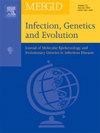揭示IL-17A变异在肺结核中的作用:来自病例对照研究的见解。
IF 2.6
4区 医学
Q3 INFECTIOUS DISEASES
引用次数: 0
摘要
目的:本研究旨在探讨某些白介素-17 A (IL-17 A)多态性,特别是rs2275913和rs8193036与肺结核(PTB)易感性之间的关系。考虑到IL-17 A在调节免疫反应中的功能,特别是在细菌感染方面,我们试图确定IL-17 A基因的变化是否对被检查组的PTB有影响。方法:我们对100名确诊肺结核患者和100名对照组进行了病例对照研究。采用聚合酶链反应-限制性片段长度多态性(PCR- rflp)和四引物扩增难突变系统(tetrao - arms PCR)方法对IL-17 A snp rs2275913和rs8193036进行基因分型。采用比值比(OR)和95% %置信区间(CI)进行统计分析,以评估多态性与PTB风险之间的关系。结果:我们的数据显示rs2275913多态性与PTB易感性升高之间存在显著关联(OR = 1.69,95 % CI: 1.09-2.61; = 0.031页)。此外,rs8193036多态性与PTB易感性增加之间存在显著关联(OR = 2.18,95 % CI: 1.46-3.27;结论:根据这项研究,IL-17 A多态性rs2275913和rs8193036与PTB易感性增加密切相关。这表明在疾病进展中存在潜在的遗传风险因素。本文章由计算机程序翻译,如有差异,请以英文原文为准。
Unraveling the role of IL-17A variants in pulmonary tuberculosis: Insights from a case-control study
Objectives
The present study aimed to investigate the association between certain interleukin-17 A (IL-17 A) polymorphisms, specifically rs2275913 and rs8193036, and the susceptibility to pulmonary tuberculosis (PTB). Considering the function of IL-17 A in regulating immunological responses, especially regarding bacterial infections, we sought to determine if variations in the IL-17 A gene effect on PTB in the examined group.
Methods
We performed a case-control study with 100 individuals who were confirmed to have PTB and 100 control subjects. Genotyping for the IL-17 A SNPs rs2275913 and rs8193036 was performed using polymerase chain reaction-restriction fragment length polymorphism (PCR-RFLP) and Tetra-primer Amplification Refractory Mutation System (Tetra-ARMS PCR) methodologies. A statistical analysis encompassing odds ratios (OR) and 95 % confidence intervals (CI) was conducted to assess the association between the polymorphisms and the risk of PTB.
Results
Our data indicated a significant connection between the rs2275913 polymorphism and elevated susceptibility to PTB (OR = 1.69, 95 % CI: 1.09–2.61; p = 0.031). Also, a significant association between the rs8193036 polymorphism and increased susceptibility to PTB (OR = 2.18, 95 % CI: 1.46–3.27; p < 0.001).
Conclusion
The IL-17 A polymorphisms rs2275913 and rs8193036 strongly correlate with increased susceptibility to PTB, according to this study. This suggests a potential genetic risk factor in the progression of the disease.
求助全文
通过发布文献求助,成功后即可免费获取论文全文。
去求助
来源期刊

Infection Genetics and Evolution
医学-传染病学
CiteScore
8.40
自引率
0.00%
发文量
215
审稿时长
82 days
期刊介绍:
(aka Journal of Molecular Epidemiology and Evolutionary Genetics of Infectious Diseases -- MEEGID)
Infectious diseases constitute one of the main challenges to medical science in the coming century. The impressive development of molecular megatechnologies and of bioinformatics have greatly increased our knowledge of the evolution, transmission and pathogenicity of infectious diseases. Research has shown that host susceptibility to many infectious diseases has a genetic basis. Furthermore, much is now known on the molecular epidemiology, evolution and virulence of pathogenic agents, as well as their resistance to drugs, vaccines, and antibiotics. Equally, research on the genetics of disease vectors has greatly improved our understanding of their systematics, has increased our capacity to identify target populations for control or intervention, and has provided detailed information on the mechanisms of insecticide resistance.
However, the genetics and evolutionary biology of hosts, pathogens and vectors have tended to develop as three separate fields of research. This artificial compartmentalisation is of concern due to our growing appreciation of the strong co-evolutionary interactions among hosts, pathogens and vectors.
Infection, Genetics and Evolution and its companion congress [MEEGID](http://www.meegidconference.com/) (for Molecular Epidemiology and Evolutionary Genetics of Infectious Diseases) are the main forum acting for the cross-fertilization between evolutionary science and biomedical research on infectious diseases.
Infection, Genetics and Evolution is the only journal that welcomes articles dealing with the genetics and evolutionary biology of hosts, pathogens and vectors, and coevolution processes among them in relation to infection and disease manifestation. All infectious models enter the scope of the journal, including pathogens of humans, animals and plants, either parasites, fungi, bacteria, viruses or prions. The journal welcomes articles dealing with genetics, population genetics, genomics, postgenomics, gene expression, evolutionary biology, population dynamics, mathematical modeling and bioinformatics. We also provide many author benefits, such as free PDFs, a liberal copyright policy, special discounts on Elsevier publications and much more. Please click here for more information on our author services .
 求助内容:
求助内容: 应助结果提醒方式:
应助结果提醒方式:


